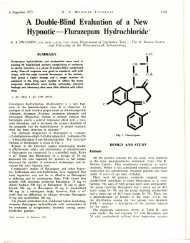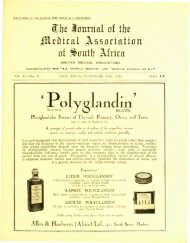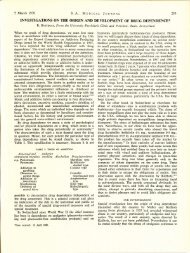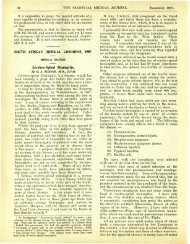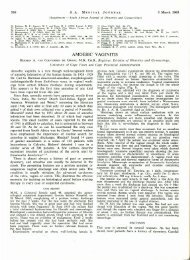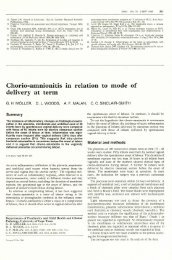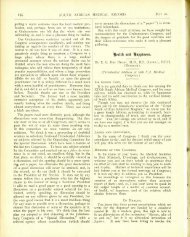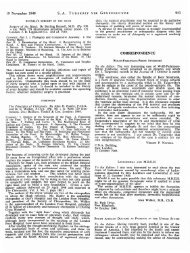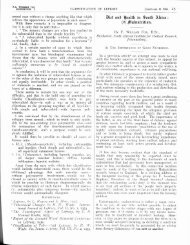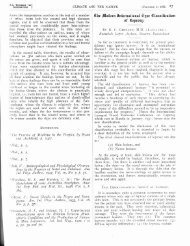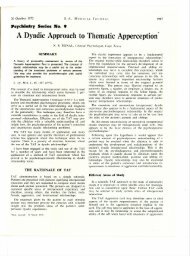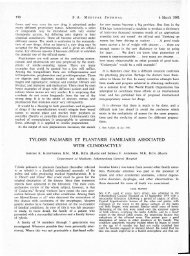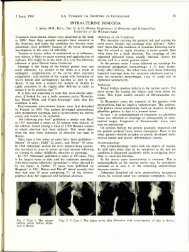3.5 POISONING BY DATURA STRAMONIUM,P de V - SAMJ Archive ...
3.5 POISONING BY DATURA STRAMONIUM,P de V - SAMJ Archive ...
3.5 POISONING BY DATURA STRAMONIUM,P de V - SAMJ Archive ...
You also want an ePaper? Increase the reach of your titles
YUMPU automatically turns print PDFs into web optimized ePapers that Google loves.
16 April 1966 S.A. MEDICAL JOUR AL<br />
<strong>POISONING</strong> <strong>BY</strong> <strong>DATURA</strong> <strong>STRAMONIUM</strong><br />
P. DE V. MEIRI 'G, M.B., B.CH., M.R.C.P. (Lo. D. AND Em '.), Medical Regisrrar, Groore Schuur Hospiral,<br />
Observatory, CP<br />
poisoning by Darura srramonium, or stinkblaar as it is<br />
known colloquially in South Africa, is not uncommon in<br />
many parts of the world, particularly in Southern and<br />
Ea t Africa.<br />
Poisoning in 2 children in one family is <strong>de</strong>scribed here<br />
to illustrate some of the typical clinical features.<br />
Though fairly common in South Africa as a whole,<br />
intoxication appears to be somewhat uncommon in Cape<br />
Town and it seems therefore worth while to report these<br />
2 cases which presented a very characteristic clinical<br />
picture that, once seen, is unlikely to be forgotten.<br />
CASE REPORTS<br />
Case 1<br />
Miriam M. aged 7, a Malay child, presented in the casualty<br />
<strong>de</strong>partment towards evening on 31 May with a history that<br />
she had eaten, 2 hours previously, some seeds from a weed<br />
growing in a vacant lot adjacent to her home; subsequently<br />
she became drowsy and extremely restless.<br />
The referring doctor's letter indicated that he found her to<br />
have tachycardia, wi<strong>de</strong>ly dilated pupils, and that she was<br />
<strong>de</strong>lirious, weak and unable to stand. In his letter he raised<br />
the possibility of some neurotoxic alkaloid.<br />
However, having <strong>de</strong>spatched the child he telephoned Prof.<br />
'. Sapeika of the Department of Pharmacology of the<br />
University of Cape Town, who consi<strong>de</strong>red that these symptoms<br />
were highly suggestive of poisoning by belladonna alkaloids,<br />
the cause of which was probably ingestion of seeds from the<br />
stinkblaar (D. srramonium) and that apart from the routine<br />
measures in all poisoning, exhibition of neostigmine was<br />
advisable. The doctor passed this information on to us and<br />
we were thus forewarned.<br />
On arrival the child was extremely excited, almost to the<br />
point of acute mania, with rapid continuous purposeless limb<br />
movements, at times muttering and at times exhibiting screaming<br />
<strong>de</strong>lirium.<br />
The pupils were wi<strong>de</strong>ly dilated and did not react to light<br />
and the pulse rate was 190 per minute. The mouth was dry<br />
and the face extremely flushed.<br />
Examination of the heart, chest and abdomen in as far as it<br />
was possible in such a restless patient, revealed no other<br />
abnormalities.<br />
Gastric lavage with a solution of sodium bicarbonate was<br />
immediately performed and neostigmine, 0·5 mg., was given<br />
intramuscularly. Forty-five minutes later the pulse rate was<br />
162 per minute, the blood pressure 100/60 mm.Hg, the pupils<br />
were still wi<strong>de</strong>ly dilated and, though she was still excited and<br />
<strong>de</strong>lirious, she had lost the continuous maniacal excitement<br />
with which she presented in casualty.<br />
The neostigmine was repeated in the same dosage and an<br />
hour later her pulse was 132 per minute and she was fairly<br />
quiet, though still in a confused state with apparent hallucinations.<br />
Every now and then she would exhibit outbursts of wild<br />
excitement during which she would lash out against the cot<br />
si<strong>de</strong>s with her arms and legs; it appeared likely that a convulsion<br />
might occur at any moment. She was therefore given<br />
15 mg. phenobarbitone intramuscularly which, though it may<br />
well have prevented a convulsion, had a rather disappointing<br />
effect on her maniacal outbursts.<br />
The advice of Professor Sapeika was again sought and he<br />
suggested that nothing further would now be gained from<br />
repeating the neostigmine. He felt that he would have preferred<br />
a shorter-acting barbiturate in preference to phenobarbitone,<br />
but that now the most useful drug would be one of<br />
the phenothiazine <strong>de</strong>rivatives.<br />
She was given 25 mg. sparine intramuscularly and gradually<br />
settled into a fitful sleep; this was undoubtedly partly due to<br />
the action of the phenobarbitone. She was <strong>de</strong>tained in hospital<br />
311<br />
for a further 36 hours, and apart from a transient mild<br />
pyrexia and a <strong>de</strong>sire to sleep for most of the next day she<br />
suffered no further ill-effects.<br />
On discharge on the morning of 2 June, the pupils were<br />
still somewhat dilated and very sluggishly reactive to light.<br />
The child was seen finally on 4 June when she was noted to<br />
be a normal, alert and quiet child who showed no aftereffects;<br />
her rather dilated pupils now reacted briskly to light.<br />
Case 2<br />
Moerida M. aged 4. Shortly after Miriam had been sent to<br />
hospital her younger sister exhibited almost i<strong>de</strong>ntical symptoms.<br />
She was brought hurriedly to the casualty <strong>de</strong>partment<br />
where she arrived half-an-hour after her sister. She was semicomatose,<br />
but very restless and reacted promptly to mildly<br />
painful stimuli.<br />
Her pulse rate was 180 per minute. She had wi<strong>de</strong>ly dilated<br />
pupils and a dry mouth. Her face, too, was noted to be<br />
intensely flushed. There were no other abnormal physical<br />
signs elicited on as full an examination as the circumstances<br />
would permit and a gastric lavage was performed followed by<br />
an intramuscular injection of 0·5 mg. of neostigmine.<br />
An hour later her pulse was 140 per minute, she was conscious<br />
but confused, restless and twitching and the pupils<br />
were still wi<strong>de</strong>ly dilated. She, too, had the appearance of<br />
imminent convulsions and was given phenobarbitone, 7·5 mg.<br />
intramuscularly. The effect was disappointing, but by this time<br />
expert advice had been obtained in respect of her sister and<br />
sparine, 12·5 mg., was given intramuscularly. This child did<br />
not exhibit such violent excitement as her sister, and did not<br />
Fig. I. A leaf and seed capsule of D. stramonium.
312 S.A. TYDSKRIF VIR GENEESKUNDE 16 April 1966<br />
give cause for great anxieiy. She settled down readily and<br />
slept somewhat restlessly for the remain<strong>de</strong>r of the night, being<br />
kept in hospital the following day and discharged on 2 June.<br />
At this time, her pupils were also still dilated and reacted<br />
very sluggishly to light.<br />
The father of these 2 children was requested to bring parts<br />
of the offending plant for i<strong>de</strong>ntification and he produced some<br />
leaves and a seedpod of Darura STramonium. The seedpod and<br />
one of the leaves are illustrated (Fig. I).<br />
Moerida was seen finally on 4 June when it was noted that<br />
her pupils were still somewhat dilated though they reacted<br />
briskly to light.<br />
DISCUSSIO<br />
DalUra sTramonium is common in all temperate and<br />
tropical zones. Various names by which it is known inclu<strong>de</strong><br />
Jimson weed, Jamestown weed (USA), thorn apple,<br />
Peru apple, <strong>de</strong>vil's apple and stinkblaar.<br />
The plant is a species of the nightsha<strong>de</strong> or Solanaceae<br />
family and is a large coarse herb attaining a height of<br />
3 - 6 feet. The leaves are large and angular and from 4 to<br />
6 inches long. The flowers are white or mauve and are<br />
succee<strong>de</strong>d by the egg-shaped seed capsule, the size of a<br />
walnut and covered with many sharp spines (Fig. 2).<br />
Fig. 2. The stinkblaar (D. stramonium L.) showing the main morphological<br />
characteristics. (By kind permission of the Cape Argus.)<br />
When ripe, the capsule opens into 4 parts leaving a<br />
central structure bearing numerous dark brown reniform<br />
seeds of a diameter of 2 - 3 mm.<br />
There is evi<strong>de</strong>nce that Datura stramonium an'd D. fa/uta<br />
are variants of the same species, and Dyson et al.' state<br />
that the two are morphologically i<strong>de</strong>ntical except for the<br />
purple pigment anthocyanin in the stem and flower of<br />
tatula. The alkaloids of the genus datura are atropine,<br />
hyoscine, hyoscyamine, meteloidine and nor-hyoscyamine.<br />
The leaf and seed in South Africa have yiel<strong>de</strong>d 0·5 and<br />
0·36% of total alkaloids respectively, the chief of which<br />
is hyoscyamine.'<br />
Human poisoning In South Africa IS common, mostly<br />
due to the seed. Prompt treatment is usually followed by<br />
fairly quick recovery. Poisoning usually arises from ingestion<br />
of the seeds by young children, but the seeds known<br />
as lagboontjies among schoolboys in some country<br />
schools, have been used in initiation ceremonies with<br />
hilarious though sometimes dangerous results. Poisoning<br />
is common in East Africa and here the leaf may be<br />
gathered with other greenstuffs and be responsible for<br />
poisoning.'<br />
Wholesale poisoning of African troops occurred from<br />
time to time in East Africa during the Second World War;<br />
and there have been many reports of poisoning both by<br />
ingestion of the seeds and contamination of food by the<br />
leaves and seeds in South Africa, North and South<br />
America, Egypt, East Africa, Australia, and Europe, the<br />
acci<strong>de</strong>ntal inclusion of the plant in foodstuffs being<br />
usually without serious results.<br />
Hughes'4 experience was that poisoning by the seed<br />
gave a maniacal picture with ceaseless and apparently<br />
purposeless activity, very much like the 2 cases <strong>de</strong>scribed<br />
in this report, whereas he felt from a study of reports of<br />
poisoning that ingestion of the leaf ten<strong>de</strong>d to produce a<br />
comatose picture.<br />
In a report of 2 cases resulting from the ingestion of<br />
seeds of Jimson weed, a colloquial term for this plant in<br />
Tennessee, Hughes (1939)' <strong>de</strong>scribed a very characteristic<br />
clinical picture including dryness of the tongue, wi<strong>de</strong>ly<br />
dilated pupils, maniacal and purposeless movement, sometimes<br />
with a clonic component. Diffuse erythema is so<br />
vivid at times that it may simulate the flush of scarlet<br />
fever.<br />
In practically no other condition are the pupils so<br />
wi<strong>de</strong>ly dilated, and tachycardia is invariable.<br />
Death appears to be a somewhat unusual sequel if<br />
treatment is prompt; immediate gastric lavage is mandatory.<br />
The use of various sedatives is <strong>de</strong>scribed including barbiturates,<br />
paral<strong>de</strong>hy<strong>de</strong> 4 and latterly phenothiazine <strong>de</strong>rivatives:<br />
Hughes administered phenobarbitone to control the<br />
violent clonic limb movement he <strong>de</strong>scribed in his two<br />
cases, with good results. Ismael 6 appears to be the first to<br />
have recommen<strong>de</strong>d the use of parasympathetico-mimetic<br />
drugs. He recommen<strong>de</strong>d pilocarpine and pointed out that<br />
it was difficult to judge the dose because of the impossibility<br />
of knowing the amount of actual alkaloid ingested,<br />
and he felt the safest way was to give small repeated doses<br />
regulated according to the reaction of the patient, bearing<br />
in mind that in el<strong>de</strong>rly people it has been known to cause<br />
pulmonary oe<strong>de</strong>ma.<br />
I should like to thank Prof. . Sapeika for his very helpful<br />
advice in the management of these patients, and the Curator of<br />
the Bolus Herbarium for the positive i<strong>de</strong>ntification of the<br />
specimens of D. stramonium. I should also like to thank the<br />
Cape Argus for having provi<strong>de</strong>d the illustration of a stinkblaar<br />
plant.<br />
REFERENCES<br />
1. Dyson. L. S. and Coetzee. J. A. (1943): S. Afr. J. Sci .. 40, 162.<br />
2. Wright. F. J. (1944): E. Mr. Med. J., 21, 365.<br />
3. An<strong>de</strong>rson. T. F. and McNaughton. F. (1944): Ibid., 21. 355.<br />
4. Hughes. J. W. and Clark. J. A. (1939): J. Amer. Med. Assoc.. 112,<br />
2500.<br />
5. Sapeika. '. (1965): Personal communication.<br />
6. Ismael. A. (1915): Practitioner. 94, 121.<br />
7. Watt, J. M. and Breyer-Brandwijk. M. G. (l962\: The Medicinal and<br />
Poisonous Plants of Southern and Eastern Africa. 2nd ed., p. 952.<br />
Edinburgh: E. & A. Livingstone.



